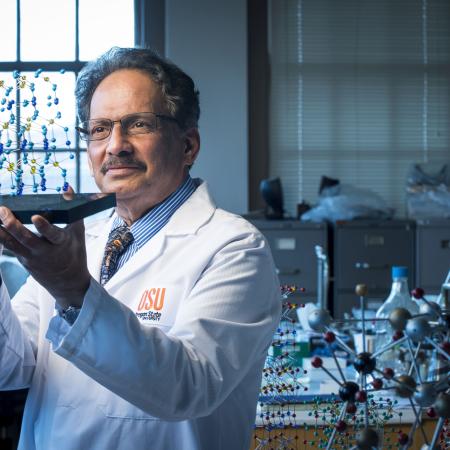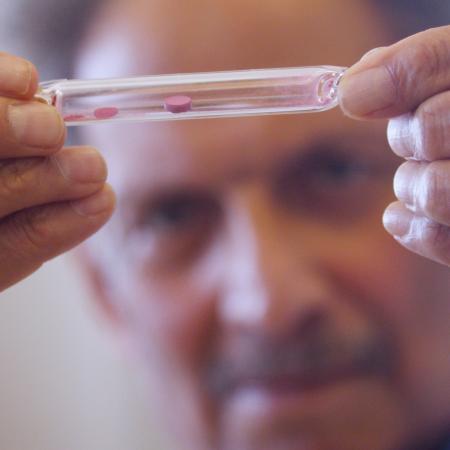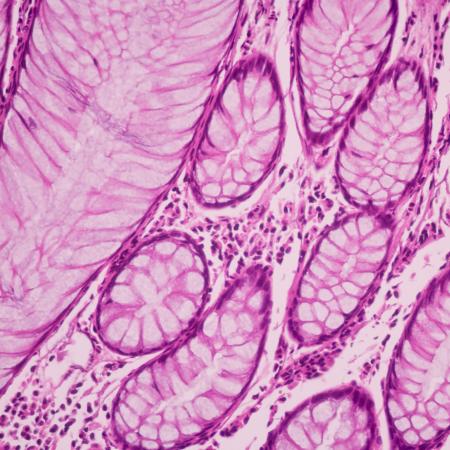Assistant chemistry professor Tim Zuehlsdorff has been at Oregon State since September 2020, but he has yet to go on campus. In fact, he hasn’t performed research in a laboratory since his first year of undergrad. Instead, his research relies primarily on computational methods, using massive supercomputers to uncover the patterns in data that experimental scientists might ignore.
“I realized very early on that experimental science wasn’t for me,” he said. “I didn’t find labs very interesting. It was kind of a combination of not being very good at experimental science and not being very patient.” Instead, he substituted the labs for extra classes in advanced mathematics and computational physics, which he found captivating.
“The nice thing about theoretical and computational work is, if it doesn’t work, I know that I have made a mistake – either in my code or there is something wrong with my theory,” he said. “In labs, there are so many other influences you can’t control.”
“I get really excited about fundamentally understanding something,” he said. “I like to sit down and think about a problem for a very long time until I finally believe I can wrap my head around why things work like they work.”
Unraveling complex systems
Zuehlsdorff’s current research aims to compute simulations of the optical properties of complex systems – sets of substances and energy whose behavior exhibits qualities that are intrinsically difficult to model. Working on a quantum level, he simulates the structures of dyes and other materials at a scale of a few hundred atoms, allowing him to model atomic structure and function on a level of detail that well exceeds any microscope.
“The work I’m doing fits neatly as a kind of theoretical computational counterpart to some of the experimental work that goes on in the chemistry department."
His insights can help understand how light-absorbing molecules in complex environments, such as the process of photosynthesis or light absorption of rhodopsin, the low-light pigment in the retina. “In these systems, the light-absorbing molecule is embedded in some form of environment, like a solvent or protein,” he said. “This embedding environment alters which color of light the molecule actually absorbs.”
Eventually, Zuehlsdorff hopes that his methods will not be limited to data that is already available but can be used predictively to assist with experimental and biomedical research. “Once I can convince myself that I can consistently reproduce these results, I can be a little more helpful,” he said. “So an experimentalist can say to me, I don’t want to make these 50 different dyes and measure the absorption properties… And then I might be able to tell them, don’t try to make all these dyes, this dye is probably the most likely candidate.”
“The nice thing with what I’m doing is that you can very easily check whether you got the right answer,” he said. With standard dyes, experimental chemists are able to quickly measure the emissions spectra, providing real results that he can compare his theoretical data to.
“In reality, the theory often lags behind the experiment,” he said. Often it can take years for scientists to understand the mechanisms behind the data, even when the results are reproducible. Zuehlsdorff hopes to someday reverse that process – eventually using simulations to determine what dyes will be most effective without the trial and error inherent in experimental research.
To make that happen, Zuehlsdorff is excited to collaborate with other researchers at OSU. “The work I’m doing fits neatly as a kind of theoretical computational counterpart to some of the experimental work that goes on in the chemistry department,” he said.
Following the data
Originally from Germany, Zuehlsdorff attributes his passion for science to his father, an aerospace engineer. “He would read science books for children to me, and one of my earliest childhood memories is him actually correcting an error he found in the book,” he said.
When he was 16 years old, he moved to the United Kingdom for the last two years of high school before attending the Imperial College of London for both his B.S. and Ph.D. in physics, the latter with theoretical physicist Peter D. Haynes. He soon realized – “If you want to study the real world in a theoretical sense, you end up using computers very quickly.”
After graduating, he began his first postdoc at Cambridge University where he soon realized that even freshly-minted Ph.D.’s still have a lot to learn. “I thought I had developed all this great understanding in my Ph.D., so all I had to do in my postdoc was apply it. And then, of course, things always turn out to be harder than one thinks,” he said.
“I worked with great scientists and mentors,” he said. “They helped me out a lot, and still do.” Their guidance helped reignite his enthusiasm for learning, motivating his decision to attend the University of California Merced for a second postdoc with computational chemist Christine Isborn.
It was a great collaboration where we figured out great things, and we were equally excited and surprised by what we found. That gave me a lot of motivation again, to just continue doing what I’m doing, and I’m very thankful to her,” he said.
Changing course
While initially, he had only intended to stay in the United States for a few years, the United Kingdom’s decision to leave the European Union caused him to reconsider his plans. After spending ten years in a country that now felt like his home, he was concerned about the impact the referendum would have on his research and began to look elsewhere.
“There is a lot of potential to collaborate with the experimentalists here, so that was quite attractive to me in coming here.”
“Only in academia do you have the environment where you’re allowed to work on a single problem for an extended period of time until you have understood it,” he said. “That’s something I really, really like.”
Wanting to remain in the Pacific Northwest, he applied to a number of universities and found Oregon State to be the best fit. “Everyone was really nice, very open and friendly,” he said. “There is a lot of potential to collaborate with the experimentalists here, so that was quite attractive to me in coming here.”
Since all of Zuehlsdorff’s research is on the computer, COVID safety protocol has necessitated remaining off-site until the situation improves. That has meant running a lab of three Ph.D. students and teaching a graduate-level class on quantum mechanical methods for molecular systems – his first as a professor – from home. “As long as I can log into the machines and run calculations, everything is fine for me. So that’s what I’m teaching my students to do.”
Of course, remotely teaching students how to use new technology is no easy task. “I really like the research I’m doing, and I like talking to students about it to explain what we are doing, and why we should care about it,” he said, explaining that can be hard to provide that same level of meaningful interaction remotely. “I’m really looking forward to finally meeting my students and colleagues face to face. That’s massive.”




